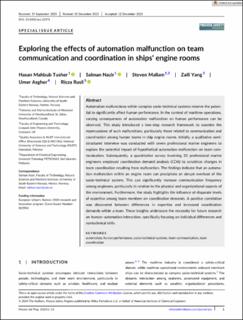| dc.contributor.author | Tusher, Hasan Mahbub | |
| dc.contributor.author | Nazir, Salman | |
| dc.contributor.author | Mallam, Steven | |
| dc.contributor.author | Yang, Zaili | |
| dc.contributor.author | Asgher, Umer | |
| dc.contributor.author | Rusli, Risza | |
| dc.date.accessioned | 2024-02-05T12:40:08Z | |
| dc.date.available | 2024-02-05T12:40:08Z | |
| dc.date.created | 2024-01-12T18:25:41Z | |
| dc.date.issued | 2024 | |
| dc.identifier.citation | Tusher, H. M., Nazir, S., Mallam, S., Yang, Z., Asgher, U., & Rusli, R. Exploring the effects of automation malfunction on team communication and coordination in ships' engine rooms. Process Safety Progress. | en_US |
| dc.identifier.issn | 1066-8527 | |
| dc.identifier.uri | https://hdl.handle.net/11250/3115623 | |
| dc.description.abstract | Automation malfunctions within complex socio-technical systems reserve the potential to significantly affect human performance. In the context of maritime operations, varying consequences of automation malfunction on human performance can be observed. This study introduced a two-step research framework to examine the repercussions of such malfunctions, particularly those related to communication and coordination among human teams in ship engine rooms. Initially, a qualitative semi-structured interview was conducted with seven professional marine engineers to explore the potential impact of hypothetical automation malfunction on team communication. Subsequently, a quantitative survey involving 32 professional marine engineers employed coordination demand analysis (CDA) to scrutinize changes in team coordination resulting from malfunction. The findings indicate that an automation malfunction within an engine room can precipitate an abrupt overload of the socio-technical system. This can significantly increase communication frequency among engineers, particularly in relation to the physical and organizational aspects of the environment. Furthermore, the study highlights the influence of disparate levels of expertise among team members on coordination demands. A positive correlation was discovered between differences in expertise and increased coordination demands within a team. These insights underscore the necessity for future research on human–automation interaction, specifically focusing on individual differences and nontechnical skills. | en_US |
| dc.language.iso | eng | en_US |
| dc.rights | Navngivelse 4.0 Internasjonal | * |
| dc.rights.uri | http://creativecommons.org/licenses/by/4.0/deed.no | * |
| dc.title | Exploring the effects of automation malfunction on team communication and coordination in ships' engine rooms | en_US |
| dc.type | Peer reviewed | en_US |
| dc.type | Journal article | en_US |
| dc.description.version | publishedVersion | en_US |
| dc.rights.holder | © 2024 The Authors. | en_US |
| dc.source.pagenumber | 13 | en_US |
| dc.source.journal | Process safety progress | en_US |
| dc.identifier.doi | https://doi.org/10.1002/prs.12571 | |
| dc.identifier.cristin | 2225702 | |
| dc.relation.project | EC/H2020/823904 | en_US |
| cristin.ispublished | true | |
| cristin.fulltext | original | |
| cristin.qualitycode | 1 | |

